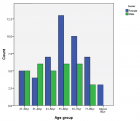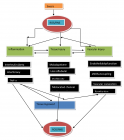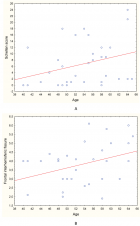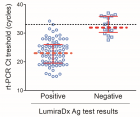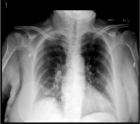Abstract
Research Article
Integration of GC-MS in identification of possible final metabolites from phytase production in Pichia Pastoris based on sorbitol induction optimization
Ndayambaje Jean Bernard*, Habarurema Gratien, Habinshuti Janvier, Ingabire Angelique, Ingabire Ange Sabine, Martin Patrick Ongol and S Meenakshisundaram
Published: 12 April, 2021 | Volume 5 - Issue 1 | Pages: 020-025
The isolation of phytase using Pichia Pastoris under methanol/sorbitol co-feeding induction technique was investigated. The biological activity of extracellular phytase after optimization with co-substrates induction in 4 liters fermentor (NBS) increased to 13250 U/ml. This led to a 509 fold increases in comparison to the other type of phytase. This effect was studied via induction with sorbitol/methanol in fermentation by Pichia Pastoris GS115 (Mut+) at 20 °C. The interference of by products; methylal, hexamine and (S)-(+)-1,2-propanediol with release of phytase in Pichia Pastoris under methanol induction were detected and cannot be repressed by methanol induction alone. The TLC was used for glycerin analysis under methanol/sorbitol induction and the results were lesser compare to that obtained during phytase production under methanol induction alone. This work showed the higher expression of heterologous proteins and by fed batch fermentation; the expression identified an advantage of producing a significant activity of phytase.
Practical applications
Plant derived products including sorbitol have been used as alternative medicines for the therapeutic treatment of various diseases, food supplements and could be used in many manufacturing processes. It serves as a culture media for bacteria, and helps to distinguish the pathogenic E. coli O157:H7 from its most other strains. Cells growing on methanol require high oxygen consumption. Sorbitol was used as an alternative cheap co-feeding for the production of proteins and is a non-repressing carbon source for AOX1 promoter with no effect on the level of r-protein at its induction phase. This report describes the isolation of phytase using Pichia Pastoris under methanol/sorbitol co-feeding induction techniques, and sorbitol showed to be a promising co-substrate, as it could enhance both cell growth and targeted protein productivity. This co-feeding and fed-batch induction technique was used for recombinant phytase production in a small and large scale production and the metabolites were analyzed.
Read Full Article HTML DOI: 10.29328/journal.abb.1001024 Cite this Article Read Full Article PDF
Keywords:
Pichia Pastoris; Sorbitol/Methanol co-feeding; Fermentation; GC-MS; Metabolites
References
- Yang J, Zhu L, Cui W, Zhang C, Li D, et al. Increased activity of MdFRK2, a high-affinity fructokinase, leads to upregulation of sorbitol metabolism and downregulation of sucrose metabolism in apple leaves. Hortic Res. 2018; 5: 71. PubMed: https://pubmed.ncbi.nlm.nih.gov/30534388/
- Oku T, Nakamura S. Digestion, absorption, fermentation, and metabolism of functional sugar substitutes and their available energy. Pure Appl Chem. 2002; 74: 1253–1261.
- Tuck C, Ly E, Bogatyrev A, Costetsou I, Gibson P, et al. Fermentable short chain carbohydrate (FODMAP) content of common plant-based foods and processed foods suitable for vegetarian- and vegan-based eating patterns. J Hum Nutr Diet. 2018; 31: 422–435. PubMed: https://pubmed.ncbi.nlm.nih.gov/29473657/
- Fredslund F, Otten H, Gemperlein S, Poulsen JCN, et al. Structural characterization of the thermostable Bradyrhizobium japonicum D-sorbitol dehydrogenase. Acta Crystallogr. F Struct Biol Commun. 216; 72: 846–852. PubMed: https://pubmed.ncbi.nlm.nih.gov/27827356/
- Rahimi A, Hosseini SN, Karimi A, Aghdasinia H, Mianroodi RA. Enhancing the efficiency of recombinant hepatitis B surface antigen production in Pichia Pastoris by employing continuous fermentation. Biochem Eng J. 2019 ; 141 : 112–119.
- Mattanovich D, Sauer M, Gasser B. Yeast biotechnology: teaching the old dog new tricks. Micro Cell Factor. 2014; 13: 34.
- Niu H, Jost L, Pirlot N, Sassi H, Daukandt M, et al. A quantitative study of methanol/sorbitol co-feeding process of a Pichia Pastoris Mut+/pAOX1-lacZ strain. Micro Cell Factor. 2013; 12: 33.
- Jin H, Liu G, Ye X, Duan Z, Li Z, et al. Enhanced porcine interferon-α production by recombinant Pichia Pastoris with a combinational control strategy of low induction temperature and high dissolved oxygen concentration. Biochem Eng J. 2010; 52: 91–98.
- Azadi S, Sadjady SK, Mortazavi SA, Naghdi N, Mahboubi A, et al. Bioprocess and downstream optimization of recombinant human growth hormone in Pichia Pastoris. Res Pharm Sci. 2018; 13 : 222–238. PubMed: https://pubmed.ncbi.nlm.nih.gov/29853932/
- Canales C, Altamirano C, Berrios J. The growth of Pichia Pastoris Mut(+) on methanol-glycerol mixtures fits to interactive dual-limited kinetics: model development and application to optimised fed-batch operation for heterologous protein production. Bioprocess. Biosyst Eng. 2018; 41: 1827–1838. PubMed: https://pubmed.ncbi.nlm.nih.gov/30196441/
- Calik P, Hoxha B, Calik G, Ozdamar TH. Hybrid fed-batch bioreactor operation design: control of substrate uptake enhances recombinant protein production in high-cell-density fermentations. J Chem Technol Biotechnol. 2018; 93: 3326–3335.
- Surendarbabu M, Meenakshisundaram S. High-cell density cultivation of recombinant Pichia Pastoris harboring fungal endoinulinase and prebiotics applications of inulo-oligosaccharides. J Environ Biol. 2019; 40: 69–75.
- Vogl T, Sturmberger L, Fauland PC, Hyden P, Fischer JE, et al. Methanol independent induction in Pichia Pastoris by simple derepressed overexpression of single transcription factors. Biotechnol Bioeng. 2018; 115: 1037–1050. PubMed: https://pubmed.ncbi.nlm.nih.gov/29280481/
- Wang J, Wang X, Shi L, Zhang Y, Zhou X, et al. Reduced methanol input induces increased protein output by AOX1 promoter in a trans-acting elements engineered Pichia pastoris. J Ind Microbiol Biotechnol. 2018; 45: 25–30. PubMed: https://pubmed.ncbi.nlm.nih.gov/29230578/
- Luo G, Tian J, Huang H, An L. Improving heterologous expression of porcine follicle-stimulating hormone in Pichia pastoris by integrating molecular strategies and culture condition optimization. Appl Microbiol Biotechnol. 2018; 102 : 8867–8882. PubMed: https://pubmed.ncbi.nlm.nih.gov/30136206/
- Troshagina DS, Suleimanova AD, Itkina DL, Sharipova MR. Cloning of Phytase Genes from Pantoea Sp 3.5.1 and Bacillus ginsengihumi M2.11 in Pichia Pastoris. Bio Nano Sci. 2018; 8: 1045–1053.
- Cayetano-Cruz M, Perez de los Santos AI, Garcia-Huante Y, Santiago-Hernandez A, Pavon-Orozco P, et al. High level expression of a recombinant xylanase by Pichia Pastoris cultured in a bioreactor with methanol as the sole carbon source: Purification and biochemical characterization of the enzyme. Biochem Eng J. 2016; 112: 161–169.
- Chen L, Mohsin A, Chu J, Zhuang Y, Liu Y, et al. Enhanced Protein Production by Sorbitol Co-feeding with Methanol in Recombinant Pichia Pastoris Strains. Biotechnol Bioprocess Eng. 2017; 22: 767–773.
- Liu WC, Gong T, Wang QH, Liang X, Chen JJ, et al. Scaling-up fermentation of Pichia Pastoris to demonstration-scale using new methanol-feeding strategy and increased air pressure instead of pure oxygen supplement. Sci Rep. 2016; 18439. PubMed: https://pubmed.ncbi.nlm.nih.gov/26790977/
- Burgard J, Valli M, Graf AB, Gasser B, Mattanovich D. Biomarkers allow detection of nutrient limitations and respective supplementation for elimination in Pichia Pastoris fed-batch cultures. Microb Cell Fact. 2017; 16: 117.
- Promdonkoy P, Tang K, Sornlake W, Harnpicharnchai P, Kobayashi RS, et al. Expression and characterization of Aspergillus thermostable phytases in Pichia pastoris. FEMS Microbiol Lett. 2009; 290: 18–24. PubMed: https://pubmed.ncbi.nlm.nih.gov/19025560/
- Ribeiro Correa TL, de Queiroz MV, de Araujo EF. Cloning, recombinant expression and characterization of a new phytase from Penicillium chrysogenum. Microbiol Res. 2015 ; 170 : 205–212. PubMed: https://pubmed.ncbi.nlm.nih.gov/25023696/
- Zhao DM, Wang M, Mu XJ, Sun ML, Wang XY. Screening, cloning and overexpression of Aspergillus niger phytase (phyA) in Pichia Pastoris with favourable characteristics. Lett Appl Microbiol. 2007; 45: 522–528. PubMed: https://pubmed.ncbi.nlm.nih.gov/17958557/
- Carly F, Niu H, Delvigne F, Fickers P. Influence of methanol/sorbitol co-feeding rate on pAOX1induction in a Pichia pastoris Mut+ strain in bioreactor with limited oxygen transfer rate. J Ind Microbiol Biotechnol. 2016; 43: 517-523. PubMed: https://pubmed.ncbi.nlm.nih.gov/26790417/
- Xie Z, Fong WP, Tsang PWK. Engineering and optimization of phosphate-responsive phytase expression in Pichia Pastoris yeast for phytate hydrolysis. Enzyme Microb Technol. 2020. PubMed: https://pubmed.ncbi.nlm.nih.gov/32423670/
- Karbalaei M, Rezaee SA, Farsiani H. Pichia Pastoris: A highly successful expression system for optimal synthesis of heterologous proteins. J Cell Physiol. 2020. PubMed: https://www.ncbi.nlm.nih.gov/pmc/articles/PMC7228273/
- Prielhofer R, Cartwright SP, Graf AB, Valli M, Bill RM, et al. Pichia Pastoris regulates its gene-specific response to different carbon sources at the transcriptional, rather than the translational, level. BMC Genomics. 2015; 16: 167. PubMed: https://pubmed.ncbi.nlm.nih.gov/25887254/
- Singh P, Islam Z, Kohen A. Examinations of the chemical step in enzyme catalysis. Methods in Enzymol. 2016; 287–318. PubMed: https://pubmed.ncbi.nlm.nih.gov/27498642/
- Liu W, Zhou F, Xia D, Shiloach J. Expression of multidrug transporter P‐glycoprotein in Pichia Pastoris affects the host's methanol metabolism. Microb Biotechnol. 2019; 12: 1226-1236. PubMed: https://pubmed.ncbi.nlm.nih.gov/31131547/
Figures:

Figure 1

Figure 2

Figure 3
Similar Articles
-
Integration of GC-MS in identification of possible final metabolites from phytase production in Pichia Pastoris based on sorbitol induction optimizationNdayambaje Jean Bernard*,Habarurema Gratien,Habinshuti Janvier,Ingabire Angelique,Ingabire Ange Sabine,Martin Patrick Ongol,S Meenakshisundaram. Integration of GC-MS in identification of possible final metabolites from phytase production in Pichia Pastoris based on sorbitol induction optimization. . 2021 doi: 10.29328/journal.abb.1001024; 5: 020-025
-
Microalgal Derivatives as Potential Nutraceutical and Pharmaceutical: Boon to Human BeingsNamrata Dash, Amit Kumar Bajhaiya, Chandrashaker B, Poornachandar Gugulothu*. Microalgal Derivatives as Potential Nutraceutical and Pharmaceutical: Boon to Human Beings. . 2024 doi: 10.29328/journal.abb.1001040; 8: 0170-026
Recently Viewed
-
Sex after Neurosurgery–Limitations, Recommendations, and the Impact on Patient’s Well-beingMor Levi Rivka*, Csaba L Dégi. Sex after Neurosurgery–Limitations, Recommendations, and the Impact on Patient’s Well-being. J Neurosci Neurol Disord. 2024: doi: 10.29328/journal.jnnd.1001099; 8: 064-068
-
Physiotherapy Undergraduate Students’ Perception About Clinical Education; A Qualitative StudyPravakar Timalsina*,Bimika Khadgi. Physiotherapy Undergraduate Students’ Perception About Clinical Education; A Qualitative Study. J Nov Physiother Rehabil. 2024: doi: 10.29328/journal.jnpr.1001063; 8: 043-052
-
Clinical Significance of Anterograde Angiography for Preoperative Evaluation in Patients with Varicose VeinsYi Liu,Dong Liu#,Junchen Li#,Tianqing Yao,Yincheng Ran,Ke Tian,Haonan Zhou,Lei Zhou,Zhumin Cao*,Kai Deng*. Clinical Significance of Anterograde Angiography for Preoperative Evaluation in Patients with Varicose Veins. J Radiol Oncol. 2025: doi: 10.29328/journal.jro.1001073; 9: 001-006
-
Regional Anesthesia Challenges in a Pregnant Patient with VACTERL Association: A Case ReportUzma Khanam*,Abid,Bhagyashri V Kumbar. Regional Anesthesia Challenges in a Pregnant Patient with VACTERL Association: A Case Report. Int J Clin Anesth Res. 2025: doi: 10.29328/journal.ijcar.1001027; 9: 010-012
-
Cystoid Macular Oedema Secondary to Bimatoprost in a Patient with Primary Open Angle GlaucomaKonstantinos Kyratzoglou*,Katie Morton. Cystoid Macular Oedema Secondary to Bimatoprost in a Patient with Primary Open Angle Glaucoma. Int J Clin Exp Ophthalmol. 2025: doi: 10.29328/journal.ijceo.1001059; 9: 001-003
Most Viewed
-
Evaluation of Biostimulants Based on Recovered Protein Hydrolysates from Animal By-products as Plant Growth EnhancersH Pérez-Aguilar*, M Lacruz-Asaro, F Arán-Ais. Evaluation of Biostimulants Based on Recovered Protein Hydrolysates from Animal By-products as Plant Growth Enhancers. J Plant Sci Phytopathol. 2023 doi: 10.29328/journal.jpsp.1001104; 7: 042-047
-
Sinonasal Myxoma Extending into the Orbit in a 4-Year Old: A Case PresentationJulian A Purrinos*, Ramzi Younis. Sinonasal Myxoma Extending into the Orbit in a 4-Year Old: A Case Presentation. Arch Case Rep. 2024 doi: 10.29328/journal.acr.1001099; 8: 075-077
-
Feasibility study of magnetic sensing for detecting single-neuron action potentialsDenis Tonini,Kai Wu,Renata Saha,Jian-Ping Wang*. Feasibility study of magnetic sensing for detecting single-neuron action potentials. Ann Biomed Sci Eng. 2022 doi: 10.29328/journal.abse.1001018; 6: 019-029
-
Pediatric Dysgerminoma: Unveiling a Rare Ovarian TumorFaten Limaiem*, Khalil Saffar, Ahmed Halouani. Pediatric Dysgerminoma: Unveiling a Rare Ovarian Tumor. Arch Case Rep. 2024 doi: 10.29328/journal.acr.1001087; 8: 010-013
-
Physical activity can change the physiological and psychological circumstances during COVID-19 pandemic: A narrative reviewKhashayar Maroufi*. Physical activity can change the physiological and psychological circumstances during COVID-19 pandemic: A narrative review. J Sports Med Ther. 2021 doi: 10.29328/journal.jsmt.1001051; 6: 001-007

HSPI: We're glad you're here. Please click "create a new Query" if you are a new visitor to our website and need further information from us.
If you are already a member of our network and need to keep track of any developments regarding a question you have already submitted, click "take me to my Query."






